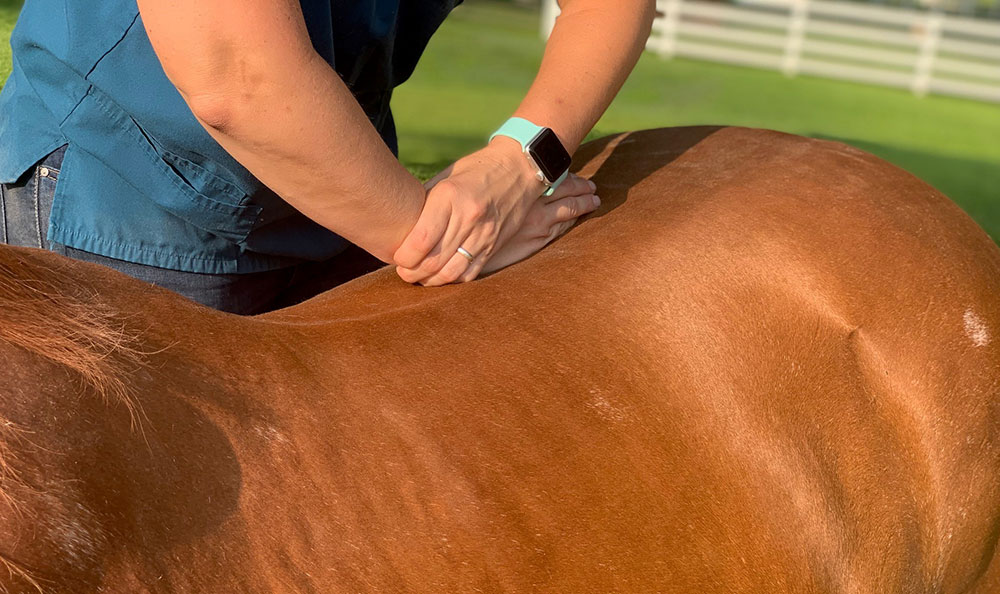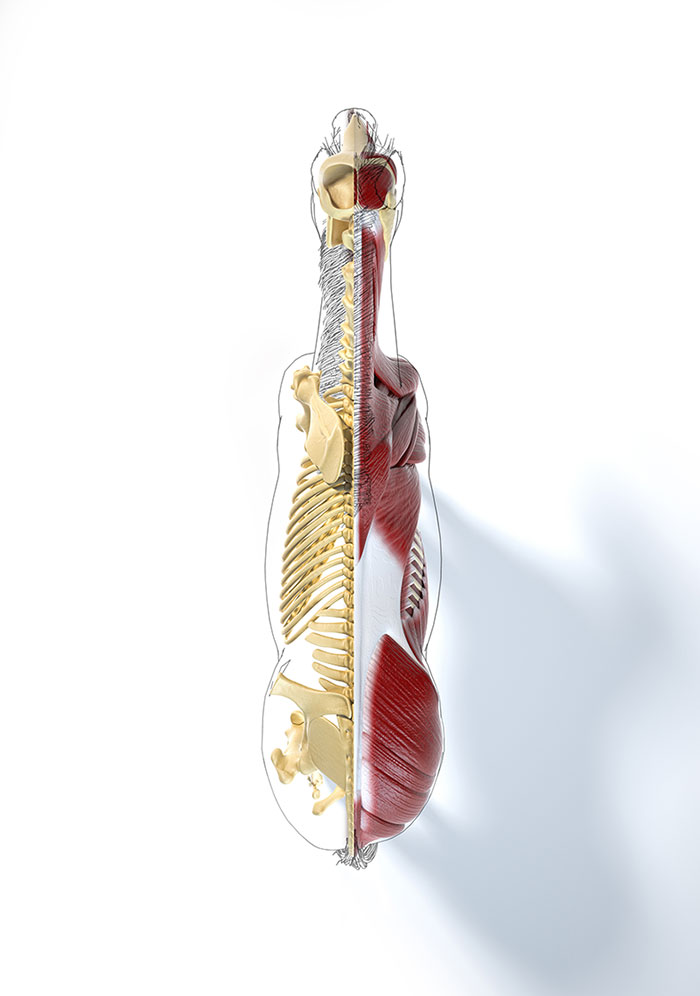

Dr. Lacey is a Certified Veterinary Medical Manipulation Practitioner (CVMMP). She received her training in Veterinary Medical Manipulation at the Integrative Veterinary Medical Institute in Reddick, FL.
What is Equine Veterinary Medical Manipulation? Is it the same as Chiropractic?
Spinal manipulation is very similar to chiropractic - the examination and manipulations have the same goal, which is to restore normal function and range of motion. Chiropractic is limited to use in humans and must be performed by a Doctor of Chiropractic. When applied to animals, this type of manipulative therapy is correctly called spinal manipulation or veterinary medical manipulation. EVMM begins with an exam of the equine spine and limb joints to find restrictions or areas of decreased range of motion. Specific manipulations, or adjustments, are then used to restore normal range of motion (ROM) and normal function to the joint(s). These manipulations involve a high velocity, low amplitude (HVLA) thrust directed in the plane of the joint to correctly and safely restore ROM. Specific knowledge of anatomy and extensive training is required to correct a restriction, not extreme strength.
Additional Information
Dr. Lacey’s EVMM training is through the Integrative Veterinary Medical Institute. This is the only medical manipulation course offered exclusively to veterinarians, focused specifically on equine practice. This program has a strong foundation in equine anatomy and neurology. Discussion of conventional and integrative veterinary medicine, diagnostics, and treatments, as well as hands-on wet labs in radiology, ultrasound, anatomy and biomechanics offers a well-rounded, in-depth education. Dr. Lacey’s goals for becoming a Certified Veterinary Medical Manipulation Practitioner (CVMMP) originated from a desire to better solve discreet lameness issues and to provide preventative medicine for the wellbeing of your horse which contributes to allowing your horse to perform at his best.
A restriction is an area of the spine or joint that is “restricted” and unable to move. Restrictions are caused by trauma, confinement, exercise, and age. They can be worsened by poor saddle fit, an unbalanced rider, poor hoof balance, and lack of cross-training and/or proper conditioning. Common areas for restrictions include the TMJ, poll, lower neck, back, pelvis and sacrum. Using the terms “out” and “stuck” can be misleading. Adjustments (spinal manipulations) do not actually put bones back into place, but rather free up movement to allow for normal range of motion.
Decreased flexibility, increased stiffness, resistance and often pain are all secondary to the decreased range of motion caused by a restriction. Additionally, misaligned vertebrae can cause problems at the level of the spinal cord, as well as where nerves exit between two vertebrae. This can be very painful. Horses may have a change in posture or compensation to avoid pain, creating further restrictions, additional injuries and/or lameness. Furthermore, information flowing through the nervous system is slowed decreasing the ability of the nervous systems to send and receive information to and from muscles, resulting in missteps/tripping, shortened strides, muscle damage and atrophy, joint and tendon injury and poor performance.
A restriction is corrected by a spinal (chiropractic) manipulation adjustment. This involves proper knowledge of anatomy, specific training, and a high velocity, low amplitude thrust directed in the plane of the joint. It does not require extreme strength. When performed correctly this will remove the restriction and restore normal range of motion.
There are many signs of restrictions, but often they involve a painful or compensatory gait or postural change, poor performance and/or refusal to work. Below is a brief list of some of the signs of restrictions:
- Change in behavior or attitude, while saddling, riding, etc.
- Change in performance or decreased energy
- Girthiness
- Refusing jumps or changing in jumping style
- Resistance to collect or laterally bend
- Hard on one rein
- Sticking tongue out
- Avoiding bit contact
- Difficulty with one lead, always landing on the same lead after a jump
- Wringing tail
- Stiffness
- Shortened stride
- Muscle atrophy
- Difficulty flexing at the poll
- Lameness
- Bucking, especially in gait changes like trot to canter
- Poor muscle development
- Asymmetrical sweat pattern
- Dragging toes
As a horse owner, you can monitor for signs of restrictions by assessing your horse routinely for:
- Normal range of motion or changes in range of motion - Can your horse bend in both directions with the same ease? Back up normally? Any changes felt under saddle?
- Appropriate muscling - Are muscles the same size on both sides of the horse? Pain? Areas of tension or muscle loss?
- Proper posture - Does your horse stand square or always with one foot pointed forward or rested?
If you notice any of the above signs or changes in your routine monitoring, it may be time to schedule an appointment. Also, Dr. Lacey discusses these monitoring techniques with owners during spinal manipulation appointments. You will also be provided with exercises to minimize restrictions. If you have any questions, please just ask!
The number of appointments needed depends on the condition being treated, how long the problem has been going on, horse’s age and response to treatment. Generally, problems that have been going on for a long time will require more sessions and may require monthly maintenance. Newer conditions will often require less sessions.
High level performance horses benefit from routine sessions every 4-6 weeks. This schedule allows Dr. Lacey to remove restrictions before they cause secondary and compensatory problems. Pre-show adjustments are an excellent way to ensure your horse is in optimal showing condition. However, it is important to discuss timing with Dr. Lacey, especially if this is your horse’s first adjustment.
You do not need to be client of AVS Equine Hospital to request EVMM for your horse, nor do you need to switch all your horse’s healthcare over. Whether you came to AVS Equine on your own or on a referral basis, complete medical records, including any recommendations for additional medical treatments, will be forwarded to your veterinarian. Dr. Lacey strongly believes in working cooperatively with other area veterinarians.
